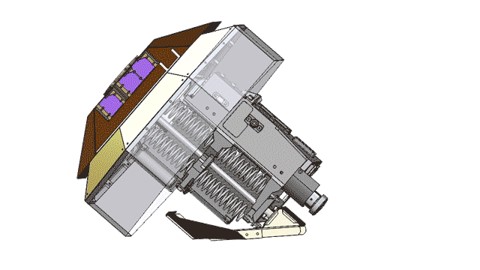About Lunar Excursion Vehicle (LEV) Project
Lunar Excursion Vehicle-1 (LEV-1) is the small probe on the Japanese Lunar landing mission SLIM. In this page, LEV-1 design, subsystems are detailed. As main mission of LEV-1, we attempt to send the information that LEV-1 collects on the real moon surface. In the following page, the details of the experiment and how to join it are explained.
LEV-1
JAXA is planning a tiny optional payload named Lunar Excursion Vehicle (LEV) for the Japanese Lunar landing mission SLIM. The deployable payload of LEV-1 is released from the lander after it has terminated the deceleration at the altitude of few meters above the Lunar surface. Then it will move over the Lunar surface autonomously. The obtained data are transmitted directly to the Ground. For SLIM project details, please see
here
Features for amateur communication
LEV-1 is not a satellite but a small rover for the moon surface. Therefore, LEV-1 will be operating under unusual two parameters:
- Lifetime
After landing, LEV-1 will be under severe thermal conditions. The expected lifetime is as long as a few days or 30 minutes at worst.
- Orbit
The orbit of LEV-1 is the same as that of moon.
Structure
LEV-1 envelope area is 400 mm x 400 mm x 400 mm. Appearance is as follow:

Electric system
| item | name | note |
| OBC | OBC | |
| sensor | camera | |
| 3ch wide range accelerometer | |
| Communication | UHF TX/RX | |
| S-band TX | S-band TX is autonomously controlled by only OBC. |
| Actuator | 2DOF (hop/turn) | |
| power | solar cell | |
| secondary battery | |
Power budget
LEV-1 has 8-parallel solar cell array and 6 series battery cell. LEV-1 can manage around ten watt.
Telemetry details
Telemetry format of LEV-1 stands on
CCSDS. The contents of telemetry are under developing.
lind budget
Uplink
| item | value | note |
| frequency | 435 [MHz] | |
| transmition power | 27.0 [dBW] | 500 [W] |
| Tx antenna gain | 31.6 [dBi] | |
| EIRP | 58.6 [dBW] | |
| Tx pointing loss | 0 [dB] | |
| free space loss | -197.3 [dB] | 400,000[km] |
| Rx pointing loss | 0.0 [dB] | |
| Rx antenna gain | 3.0 [dBi] | |
| system noise temperature | 461.3 [K] | |
| G/T | -23.6 [dB/K] | |
| achived C/NO | 66.3 [dB·Hz] | |
| modulation index | 0.0 [rad] | command (FSK) |
| modulation loss | 0.0 [dB] | |
| hardware aging | 1.0 [dB] | |
| bitrate / bandwidth | 41.8 [dB·Hz] | 15000[Hz] (filter BW) FSK, 300[bps] |
| coding gain | 0[dB] | |
| required Eb/No or S/N | 12.3 [dB] | BER 10e-4 |
| required C/No or S/N | 55.1 [dB·Hz] | |
| margin | 11.2 [dB] | |
downlink
| item | value | note |
| frequency | 437.31 [MHz] | |
| transmition power | 0 [dBW] | 1 [W] |
| Tx cable loss | -0.5 [dB] | |
| Tx antenna gain | 3 [dBi] | |
| EIRP | 2.5 [dBW] | |
| Tx pointing loss | 0.0 [dB] | |
| free space loss | -197.3 [dB] | 400,000[km] |
| Rx pointing loss | 0 [dB] | |
| Rx antenna gain | 31.6 [dBi] | |
| received power | -144.4 [dBm] | |
| system noise temperature | 120 [K] | |
| G/T | 9.9 [dB/K] | |
| achived C/NO | 43.7[dB·Hz] | |
For PSK
| modulation index | 0.0 [rad] | PSK 31[bps] |
| modulation loss | 0.0 [dB] | |
| hardware aging | 1.0 [dB] | |
| bitrate / bandwidth | 14.9 [dB·Hz] | 31 [bps] |
| coding gain | 0.0 [dB] | |
| required Eb/No or S/N | 9.6 [dB] | BER 10e-5 |
| required C/No or S/N | 25.5 [dB·Hz] | |
| margin | 18.2 [dB] | |
For carrier
| modulation index | 1.0 [rad] | carrier |
| modulation loss | 2.3 [dB] | |
| hardware aging | | |
| bitrate / bandwidth | 10.0 [dB·Hz] | |
| coding gain | 5.1 [dB] | |
| required Eb/No or S/N | 13.5 [dB] | BER 10e-5 |
| required C/No or S/N | 25.8 [dB·Hz] | |
| margin | 17.9 [dB] | |
For PCM-PSK-PM
| modulation index | 1.0 [rad] | PCM-PSK-PM 32[bps] |
| modulation loss | 4.1 [dB] | |
| hardware aging | 1.0 [dB] | |
| bitrate / bandwidth | 15.1 [dB·Hz] | 32 [bps] |
| coding gain | 5.1 [dB] | |
| required Eb/No or S/N | 9.6 [dB] | BER 10e-5 |
| required C/No or S/N | 24.7 [dB·Hz] | |
| margin | 19.0 [dB] | |
